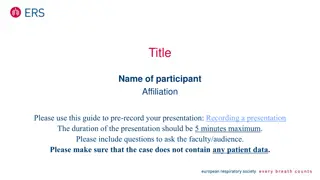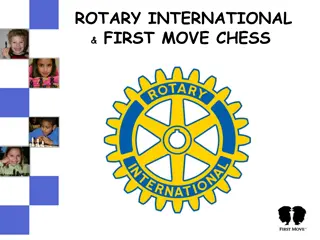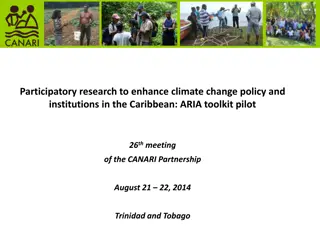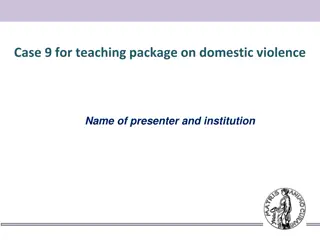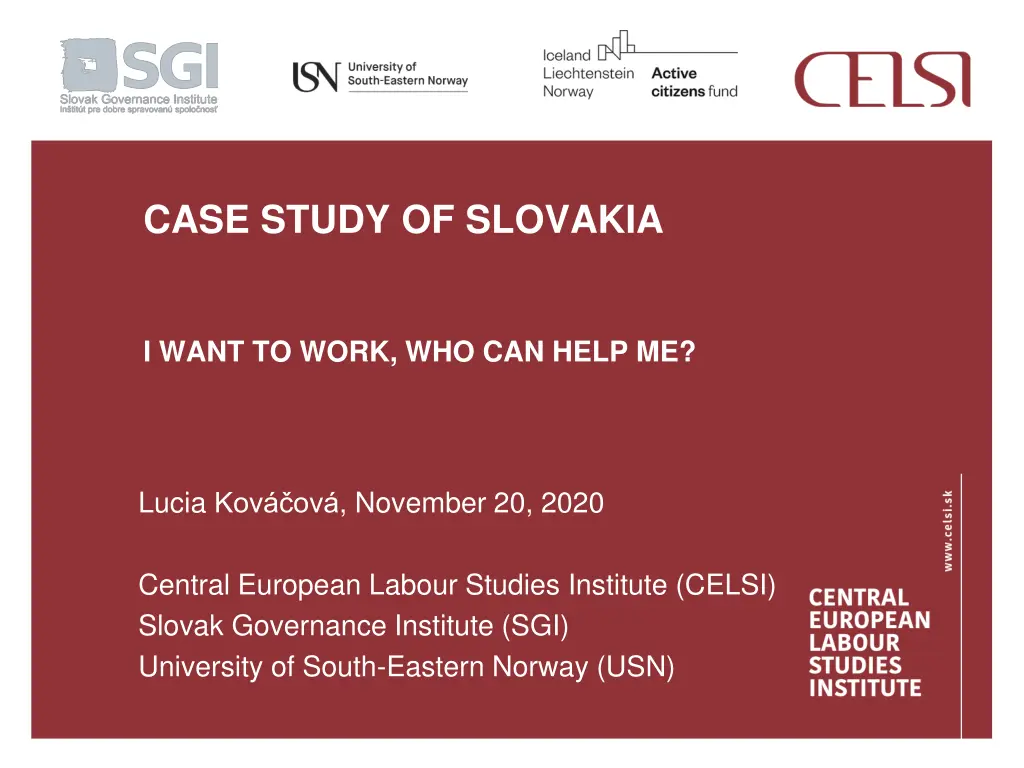
Labour Integration of People with Disabilities in Slovakia: A Case Study
Explore a comprehensive case study on labour integration of people with disabilities in Slovakia, analyzing legislation, implementation practices, and stakeholder cooperation. Discover trends, challenges, and policy tools aimed at enhancing employment opportunities for individuals with disabilities in the region.
Download Presentation

Please find below an Image/Link to download the presentation.
The content on the website is provided AS IS for your information and personal use only. It may not be sold, licensed, or shared on other websites without obtaining consent from the author. If you encounter any issues during the download, it is possible that the publisher has removed the file from their server.
You are allowed to download the files provided on this website for personal or commercial use, subject to the condition that they are used lawfully. All files are the property of their respective owners.
The content on the website is provided AS IS for your information and personal use only. It may not be sold, licensed, or shared on other websites without obtaining consent from the author.
E N D
Presentation Transcript
CASE STUDY OF SLOVAKIA I WANT TO WORK, WHO CAN HELP ME? Lucia Kov ov , November 20, 2020 Central European Labour Studies Institute (CELSI) Slovak Governance Institute (SGI) University of South-Eastern Norway (USN)
Project description and methodology Project duration June 2019 December 2020 Aim of the research: To analyse legislation and implementation practice in labour integration of people w/ disabilities To map out and facilitate cooperation between key stakeholders Methods: Desk research and 35 semi-structured interviews with representatives of public administration, trade unions, employers, and NGOs (October 2019 February 2020) Definition of people with disabilities (PwD): 1. Formal status of PwD: Recipients of disability pensions (Social Insurance Company) People with severe disabilities (Labour Offices) 2. w/o formal status of PwD (e.g. people after long-medical treatment) Special focus on the people with multiple disadvantages (ethnic background, homelessness)
Data about people with disabilities in Slovakia 2015 2016 2017 2018 2019 Recipients with the decline 40-70% 130 784 135 148 138 937 143 231 143 793 Recipients with the decline over 70% 103 667 99 983 96 769 94 385 90 553 Total number of recipients jjjof pensions for PwD 246 132 248 160 249 966 237 616 234 346 Number of registered job seekers with PwDs 12 917 10 800 8 018 6 439 5 808 Overall number of job- seekers 354 582 300 988 227 542 181 703 168 030 % portion of PwD in the total number of registered job seekers 3,64% 3,59% 3,52% 3,54% 3,46% Source: Soci lna pois ov a, stredie pr ce
Labour integration of PwD in Slovakia EU-SILC (2018): 22% of people (16yr+) in Slovakia self-declared long- lasting limitations in usual activities due to health problem (EU-27 average is 17.3%) Recipients of disability pensions made up only about 7.2% of the population (16-62 yr old) (SP 2016) Trends in labour integration of PwD: Increasing trend in the employment rate among recipients of disability pensions ( HP, IVP a ISP, 2020) LFS (2015): employment rate of PwD only 16.6% in comparison with 67.7% of the employment of the whole population; PwD are less economically active, more vulnerable are elderly and people with lower educational attainment (Ondru ov et al., 2017)
Policy tool Description Anti-discrimination measures and strict dismissal conditions Special legal protection of PwD Financial contributions on sheltered-employment, self- employment, a job preservation scheme, work assistance contribution, etc. Active labour market policies For the firms with more than 20 employees (3.2% of the workforce) Employment quotas Integration and placement financial incentive Work integration social enterprises (as a part of ALMP) Group or individual counselling provided by PES or Supported Employment Agencies Counselling services E.g., socially responsible public procurement Soft policies implemented by firms, state institutions or TUs
Integration of people with disabilities as an agenda Labour integration of PwD is a primary activity mainly for several NGOs and state institutions Most of the organisation deal with the integration of PwD only as a non-core agenda Even though the respondents from several organisations claimed that they do not deal with integration of PwD, based on the description of the activities they conduct it seems that they do have experience with this agenda Some organisations (mainly NGOs) deal with the integration of people with multiple disadvantages Type of organisation Do not deal with labour integration of PwD Labour integration of PwD as a core business Labour integration of PwD as a non- core business Employers 3 0 1 State/public administration 3 4 7 Trade unions 1 1 4 NGOs 1 7 9 Total 8 12 21
Exchange of information and knowledge; trainings Practical support with placement of PwD at the job market Providing support e.g. in applying for the medical equipment or disability pension, identifying NEETs, communicating with employers Between NGOs and state institutions, exchange of practical information about particular diagnoses and good practices, training provided to employers by NGOs, counselling Main areas of cooperation Financial support provided to NGOs, social enterprises Collective bargaining and drafting of legislation Socially responsible public procurement, grants and financial contributions Trade unions - less active, cooperation mainly between NGOs and state institutions more active
Barriers in cooperation and potential facilitators of cooperation identified by stakeholders Barriers Stakeholders Facilitators Stakeholders State, NGOs, TUs TUs, state, employers A lack of willingness to cooperate Legislative framework Employers, state, NGOs NGOs, state A lack of personal capacities Personal contacts NGOs NGOs, employers A lack of financial resources Know-how and experience NGOs NGOs, employers Rivalry among NGOs competing for finances and legitimacy Access to financial resources NGOs, TUs, state NGOs A lack of information State support
Areas of potential cooperation Areas of potential cooperation Examples Cooperation between medical facilities, social field workers, Labour offices, school facilities, greater involvement of professional associations Cross-sector cooperation and involvement of new stakeholders On the company and sectoral level; integration of policy tools in collective agreements Strengthening cooperation in collective bargaining In job-seeking, good practices in integration at workplaces Exchange of good practices and tackling prejudices Between social enterprises and patient organisations; personal assistance services and Labour Offices Strengthening existing cooperation People with mental disabilities, socially responsible public procurement Strengthening cooperation regarding the particular target groups or policy tools NGOs, Higher territorial units should participate more in formulating priorities Cooperation in formulating priorities for the Structural funds
Labour integration policies in Norway and Slovakia Criteria Norway Slovakia Inclusive subgroups disabilities approach; of different PwD with formal status; definition of disability based on the medical assessment Target persons with disabilities groups/definition of persons with Decentralised system; competencies to employers, more diverse policies but coordinated Centralised system of policies; financial incentives and sheltered employment as key policies Overall integration disabilities approach of to labour with delegation of persons Place and then train Train and then place Rationale integration behind labour Aim to place job-seekers at the primary market with support and mentoring Sheltered weak transition aspect employment with a Transition policies: sheltered employment Broad competences; employer as an equal partner implementation phase Sanction-based enough employers approach; provided not to Role of employers in the support Trade unions are active at the tripartite level implementation practice Less active; integration of PwD is not a key agenda at the national tripartite level; Role of trade unions and in the






